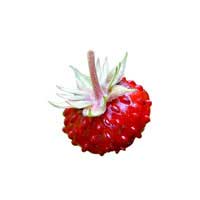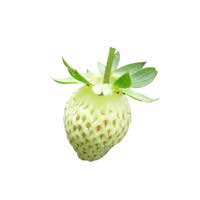 Full List of Fruits
Full List of Fruits  Forest strawberry
Forest strawberryForest strawberry
![]() Introduction of Forest strawberry
Introduction of Forest strawberry
Scientific name - Fragaria vesca
Bionomically known as fragariavesca, forest strawberries are grown in the wild in its own natural and favorable habitat. These strawberries are also popularly known aswoodland strawberry, Alpine strawberry, European strawberry, or even fraise des bois. Forest strawberries are more of a perennial herbaceous plant that grows as a part of the rose family. This plant can mostly be spotted in the northern hemisphere growing naturally throughout the year. Going by the claims made by the archeological excavations, it is believed that the existence of wild strawberries dates back to the pre historic period. Humans those days use to consume wild strawberries and cultivated them for their domestic consumption.
Vilmorin-Andrieuxa renowned seed producer spelled out the difference between two varieties of strawberries that is often confused to be the same. The two distinct variety of strawberries are a. the alpine strawberry and b. the wood or the wild strawberries.
The alpine strawberries are strawberries that are mostly seen sold in packed containers in the market. This fruit is easier to procure when compared to its wild variety. One can spot the difference based on the physical appearance of the fruit. The alpine strawberries are bigger than the wild ones, they have a more pointed shape, also longer and larger. The number of seeds present in an alpine strawberry varies largely as a gramme contains only 1500 seeds which is lesser in number when compared to the wood strawberries.
On the contrary wood strawberries are short and stout mostly growing on the sides of the roads of a hill top. Another trait that helps it differentiate from the alpine strawberries is its peculiar perfume and delicate flavor that it possess. The seed count in this fruit is as high as 2500 seeds in a gramme.
![]() Physical attributes of the plant
Physical attributes of the plant
Wild strawberries are creepers and grow runner plants on gravel edged roads of hill tops apart from that it is also found growing on stream sides, forest edges and fields. This plant grows up to six inches tall and the leaves of this runner are divided into three leaflets. Each leaflet of the tree grows as big as 1 to 1 and a half inches long. They are also equipped with teeth on the edges of the leaves.
The petioles are hairy with five to eleven soft hairy white flowers growing on them.
Creeping plants, like strawberries, have runners. Runners are stems which grow sideways on the surface of the soil. As the runners grow, they send up new strawberry plants.
![]() Nutritional Value of Forest strawberry
Nutritional Value of Forest strawberry
| Amount Per Serving | ||
| Serving | % Daily Value | |
| Calories | 146.0 | -- |
| Calories from Fat | 21.0 | -- |
| Total Fat | 2.5 g | 4% |
| Saturated Fat | 1.0 g | 20% |
| Cholesterol | 21.0 mg | 7% |
| Sodium | 112.0 mg | 5% |
| Potassium | 14.0 mg | 1% |
| Total Carbohydrate | 7.0 g | 2% |
| Sugars | 5.0 g | -- |
| Protein | 23.0 g | 46% |
| Fiber | 0.0 g | 0% |
![]() Cultivation of wild strawberries
Cultivation of wild strawberries
The plant of wild strawberry is not that difficult to grow as it comes across as a fast growing plant that spreads it runners across the ground to make a cover like structure. One must ensure enough space to be given while cultivating wild strawberries. This plant is flexible and can thrive in full sun to partial shade. The most ideal kind of soil it grows is the moist soil, having said that it can also withstand moderately dry conditions too. Such conditions prevail mostly during the season of fall and spring, which eventually means that these seasons are the best for cultivating wild strawberries.
This plant becomes non-productive during the season of winter and summer because of the unfavorable weather conditions. The transplantation of the strawberry can be done with ease because as the runners grow longer the strawberries are pushed from one are to the other thus encouraging a wide spread. It is recommended to divide and transplant the tree in an early stage as soon as the growth begins to appear. Transplanting can be done by lifting the plants up and pulling apart the crowns. One may also opt for easier options such as buying plants from the nurseries.
One needs to pay attention while planting wild strawberries that the crowns of the plant needs to be at ground level and should be made sure that they also need to be watered well. One must also dress the top of the soil with adequate amount of compost and mulch plants with straw in order to retain the moisture level and also to keep the fruits clean.
The plants bear the wild strawberries from the month April to June. The flowers borne by the plant are 3 to 4 inches wide adorned by 5 white petals on each flower. The wild strawberries actually the flowers that are attached to a cone like structure of the plant and it tends to grow bigger and thicker and redder. The wild strawberries consist the dry seeds on its skin.
![]() Benefits of consuming wild strawberries
Benefits of consuming wild strawberries
The juice produced by strawberries is well known for treating liver problems namely hepatitis, chronic hepatitis and liver cirrhosis. The best time of consuming this juice is early morning empty stomach. One should inculcate the habit of consuming this juice thrice a day. The liver activity is stimulated by the juice of wild strawberries in order to revive of hepatic cells and tissues in the liver.
Various other diseases and health complications such as Diabetes, goutiness, high cholesterol levels and arteriosclerosis can be prevented and sometimes even relived by a 12 day cure with wild strawberry. Such is the impact of wild strawberry on one's diet. The 12 day cure diet can also ease symptoms of rheumatism, this should be accompanied by long sun baths and expose the affected areas to sunlight for an hour every day. Some individuals can be a victim of allergy reactions and this fruit should be tested before its consumed or made part of any therapy. If tested negative on allergy tested, this fruit comes across as an excellent effect in the treatment of many skin diseases such as acne, dermatosis and psoriasis; this fruit contributes by catalyzing to the healing process.
The body also detoxifies in three forms while the process is ongoing in forms of diuresis, sweat and faeces. While yes it is enjoyed as a delight during hot summers as it is consumed in squash and also as a part of fresh ice creams, this fruit is known for its cooling effect as it increases the resistance to high temperatures and acts against fatigue and asthenia which is a common problem that tends to happen during hot seasons.
Need to know!
Known for its adaptive nature a wild strawberry plant needs minimal attention and care for its growth. One needs to ensure that the plant is watered regularly on daily basis when it's bearing a fruit. To protect the plant during harsh winters one must make sure that they should cover or mulch the plant with straw and loose leaves to retain moisture and avoid drying of plant.
Yummy in my tummy
There would not be many who would vouch for not liking strawberries. This wild berry are a very good source of vitamin C, they are a good addition to cereals, pan cakes, fruit salads and even consumed raw.


















